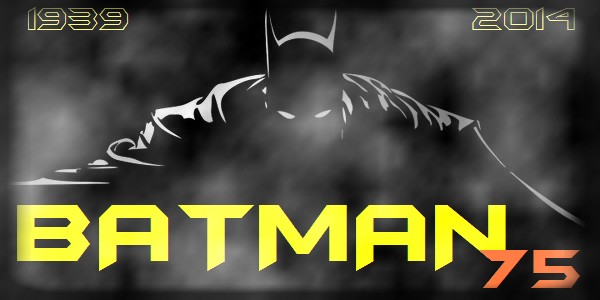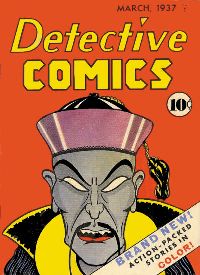| |
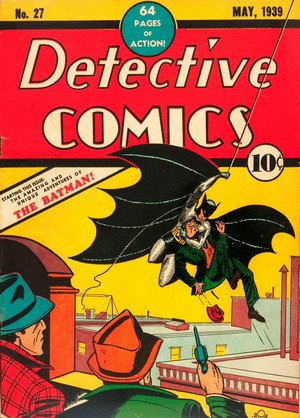 |
|
Main feature - Batman
"The Case of the Chemical
Syndicate" (6 pages) Part
1 of 1
REPRINT -
The entire issue is reprinted in Famous
First Edition C-28 and Millenium
Edition: Detective Comics #27;
"The Case of the Chemical
Syndicate" is reprinted in Batman
- A Celebration of 75 Years, Batman in
the Forties, Batman
Archives Volume 1, Batman
Chronicles Volume 1, Detective
Comics #387, Detective Comics
#627 and Batman: From the 30's to the
70's; it is also available in digital
form for mobile devices.
LOCATION -
unnamed
VILLAINS -
Alfred Stryker, Jennings
NOTES - 1st
appearances of Batman, Bruce Wayne,
Commissioner Gordon
Other features -
Speed Saunders, Buck Marshall, Bart
Regan, Crimson Avenger, Bruce Nelson, Fu
Manchu, Cosmo, Slam Bradley
|
|
|
| |
SYNOPSIS
"THE BAT-MAN, A
MYSTERIOUS AND AVENTUROUS FIGURE, FIGHTING FOR
RIGHTEOUSNESS AND APPREHENDING THE WRONG DOER, IN HIS
LONE BATTLE AGAINST THE EVIL FORCES OF SOCIETY... HIS
IDENTITY REMAINS UNKNOWN."
|
| |
| Commissioner
Gordon is being visited by his friend, young socialite
Bruce Wayne, when he receives an official phone call to
inform him that a chemical industrialist named Lambert
has been stabbed to death in his home and that it appears
as if Lambert's son were guilty of the crime. |
| |
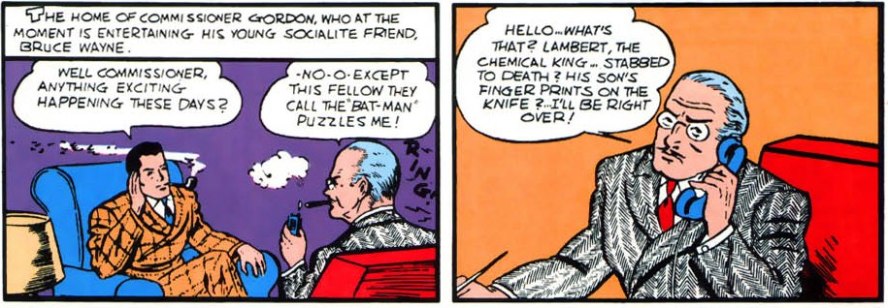
|
| |
| Joined by
Bruce Wayne Gordon hurries to the crime scene, where
young Lambert insists that he has nothing to do with the
crime and only found his father just in time to hear him
say something about a contract before he succumbed to his
wounds. Whilst still at the
Lambert Mansion the Commissioner takes a phone call from
Steve Crane, a business partner of Lambert, who wanted to
speak to the victim about an anonymous threat he
received. Gordon tells Crane to stay put and await their
arrival, but before the police can arrive Crane is shot
by an armed assailant who then steals some papers from
his home.
|
| |
| Climbing out of the window to
the roof, the two gangsters find themselves face
to face with -- The Bat-Man! The masked
vigilante knocks one burglar unconscious and
tosses the other off the roof before retrieving
and reading the document taken from the safe. He
then jumps into a car and speeds off just as the
police arrive and Gordon cries out in vain "it's
the Bat-Man! get him!".
|
|
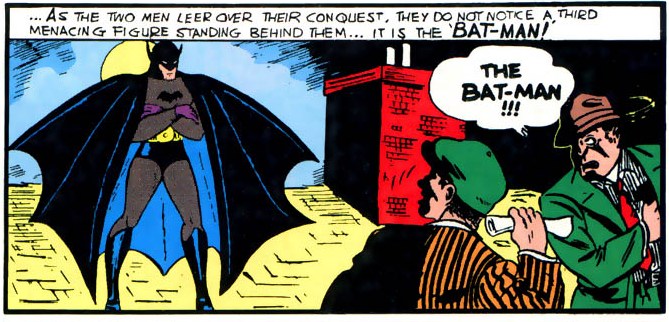 |
|
| |
| Meanwhile,
Rogers, one of the last two surviving business partners
of Lambert, pays a call on Stryker, the other surviving
partner. He is ushered in to the house by Jennings,
Stryker's man servant, who suddenly and unexpectedly
attacks him and, after dealing a blow, puts Rogers into a
glass dome gas chamber. As Jennings leaves the lab to
turn on the gas the Bat-Man arrives on the scene and
breaks the chamber with a wrench. Upon returning,
Jennings finds the Bat-Man but is quickly brought down by
the vigilante who also prevents Stryker himself from
stabbing Rogers. As Stryker - who wanted the chemical
company all to himself and not only killed his partners
but also stole their personal copies of a secret contract
which counteracted his plans - tries to shoot the
Bat-Man, the masked crimefighter punches Stryker who
tipples over backwards and falls into an acid tank. As
quickly as he has appeared the Bat-Man disappears again,
and the next morning a baffled Commissioner Gordon
discusses the matter with Bruce Wayne who seems to attach
very little credibility to the reports about this
"Bat-Man". Gordon assumes Wayne must lead a
very boring life, as nothing seems to grab his interest -
however, back at his home, we find that the Bat-Man is in
reality -- Bruce Wayne! |
| |
REVIEW
Detective
Comics #27, distributed to newsstands on April 18th 1939, easily takes
top status and importance for comic book history as it
features a whole row of vitally important
"firsts" for what would become the Batman
mythos.
|
| |
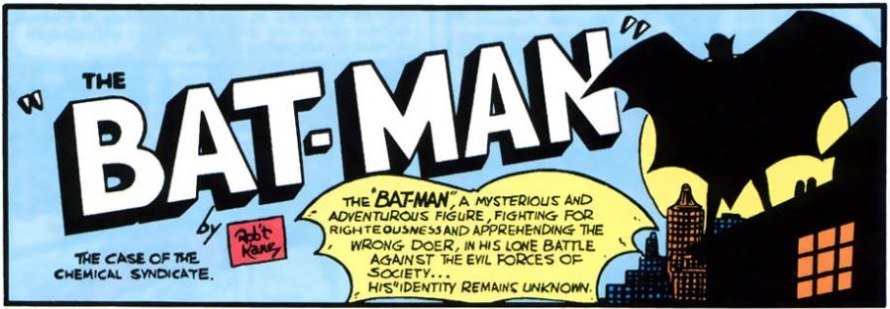
|
| |
| There is,
of course, the first appearance of The Batman (or, to be
precise, Bat-Man) himself, who already makes a
mystery entrance as a silhouette in the logo vignette
panel serving as title for the feature. He will be fully
shown only later, on the second panel of the third page
(i.e. after a third of the story is told) when
confronting the gangsters on the roof of Crane's house. Two equally important
firsts are the first appearances of Bruce Wayne and
Commissioner Gordon, right in the first panel of the
first page - instant gratification. One first however did
not take place - the exact geographical location of where
Batman's adventures take place is left unmentioned, and
indeed Gotham City had yet to be designated the Darknight
Detective's home playing field (first used by Washington Irving in
his 1807 satirical periodical Salmagundi as a
nickname for New York City, Gotham would first be
mentioned as the batman's home in Batman #4 in
1940).
|
| |
| Of course neither the story
nor the artwork would raise an eyebrow today, but
obviously they need to be considered and viewed
within the context of their own time, which was
when comic books were fundamentally anthologies
collecting several stories featuring several
different protagonists. True to its title, most
of those appearing in Detective Comics
featured crime and detection, but by way of the
anthology formula the page count for the
individual stories was very limited, thus
requiring writers and artists to cram an entire
story into a few pages. By the
standards of that time - and certainly also in
direct comparison to the other content featured
in Detective Comics #27 - the first
Batman story ever comes across as being far above
average and infused with fresh ideas and a
conceptual vitality which has kept surprisingly
well over a period of 75 years. However - there
is a twist to this.
|
|
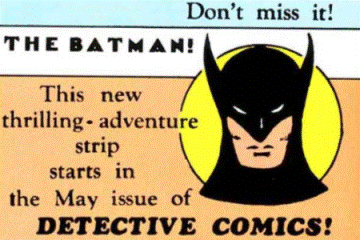
Ad for the first appearance
of the Bat-Man,
from Action Comics #12
|
|
| |
| Bill
Finger, who today is widely regarded as the major
inspirational creative source for the Batman (Porter,
2008) - together with artist Jerry Robinson and, to a
lesser degree, writer Gardner Fox - and who scripted this
very first Batman story, admitted at a later point in
time that this script "was a take-off of a
Shadow story" (Murray, 2007). |
| |
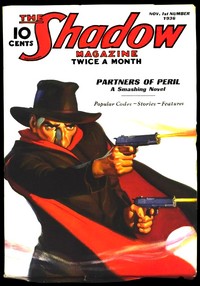 |
|
How much and
from which Shadow story Finger had been inspired
and had borrowed material remained unclear until
Anthony Tollin and Will Murray discovered the
source material in 2007, namely "Partners of
Peril", published November 1st 1936 in The
Shadow Magazine (Tollin, 2007 and Murray,
2007). The similarities are, in fact, so evident
and such a close match that "The Case of the
Chemical Syndicate" looks much more like a
straightforward adaptation than an original
creation.
But it wasn't just Bill
Finger - a good many of Bob Kane's Batman poses
have been shown to be outright swipes from other
sources, most importantly Alex Raymond's Flash
Gordon strips (Porter, 2008) and even his
well known signature in a box was copied outright
from Milton Caniff. In fact, there are so many
references to bats in "Partners of
Peril" that it raises the question if Kane
was involved in the character creation of Batman
at all (Tollin, 2007).
|
|
| |
But again,
these going-ons need to be viewed from the perspective of
the time they took place. Finger and Kane were working
for a company which had its roots deeply in the
publication of pulp novels and was only just starting out
in this new business of comic books, so it can hardly be
seen as surprising that they would borrow from what
influenced them in the first place: pulps and newspaper
strips, along with the occasional motion picture. If - as
legend would have it - the Batman was thought up over a
weekend, then it would almost seem obvious that the
result would be a concoction rather than a completely
original creation. And finally - this was the cheap side
of publication, and nobody working in it was thinking of
posteriority at all.
"In
1935, when Siegel and Shuster sold Superman, first of
all, nobody would buy it. Secondly, no one thought it
was worth anything. Third, when they got it, they had
no contract; what they got was a check, a regular
check, and back then, during the Depression, a
regular anything was good!" (Will Eisner,
in Brownstein & Schutz,2005)
But at the
end of the day, the basic idea and concept of "The
Bat-Man" clearly beats the "yet another
hardball detective" formula, and the potential of
the character is already there to be seen, even if Bob
Kane's artwork often only hints at what the Darknight
Detective would ultimately become; the imposing visuals
have yet to emerge, and they will be brought in by other
artists, who for a long time would go uncredited.
As Bradley
& Kaiser (2011) have pointed out in quite some
detail, certain aspects of the first appearance of The
Bat-Man are in sharp contrast - if not outright
opposition - to the established image and perception of
the popular culture icon. Most importantly, the Bat-Man
advocates and actively enacts what can only be termed
lynch justice by openly calling the fact that the
murderer accidentally falls into an acid tank "a
fitting end for his kind" [page 6, panel 5],
and he at least risks killing a thug (if not worse) [page
3, panel 5] by sending him "flying through
space", which under the circumstances appears
to be Bat-Man actually tossing the criminal off the roof
of a house. This is hardly the trusted guardian of law,
order and civil peace which popular culture tends to see
in Batman, to whom a human life is sacred even in the
most somber moments of his dark night vigil.
Clearly then
this shows that although the first appearance of The
Bat-Man already incorporated many conceptual elements
which would make up core elements of the mythos, he was
at this point in time a tryout - created, above all, to
build on and further exploit the success of Superman in Action
Comics - and that some substantial traits would yet
need to emerge, even if the core dynamics of the
character were already in place.
|
| |
FACTS
& FIGURES
The importance of Detective
Comics #27 and the first appearance
of Batman were recognised even within the
title itself as Detective Comics
#627 and Detective Comics #853
ran homages to what has become one of the
most iconic comic book covers ever
created.
In February 2010, a
copy of Detective Comics #27 in
very fine condition (CGC 8.0) temporarily
became the most expensive comic book ever
sold at an auction with a final price tag
of $ 1,075,000 (this attribute has since
passed to a near mint copy of Action
Comics #1 which sold for $ 2,16 Mio
in November 2011).
No original artwork
for this Batman story is known to have
survived, but production proofs for five
pages (i.e. all minus the first) were
reputedly rescued in 1975 from trash
which had been thrown out at the
apartment house where Bob Kane used to
live, and the pages were ultimately
auctioned in February 2011.
A more in-depth look
at Detective Comics #27 is
offered by the first episode of the Legends
of the Batman podcast, and
two very short motion
comic tryouts of
one panel each from Detective Comics
#27 at youtube show the special
atmosphere
contained in this first appearance of --
The Bat-Man !
|
|
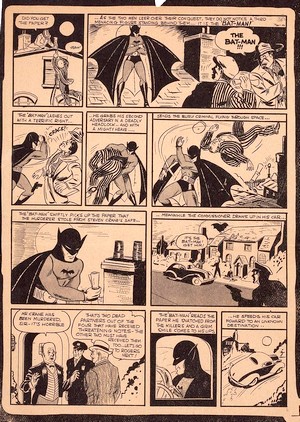
Production proof for
page 3
of Detective Comics #27
|
|
|
| |
|
| |
DETECTIVE
COMICS #28

June 1939
[Untitled]
|
|
Story - Bill
Finger
Art - Bob
Kane, Jerry Robinson
Inks - Bob
Kane
Colours - NN
Lettering - Bob
Kane
Editor - Vincent
Sullivan
Cover - Bob
Kane
|
|
|
| |
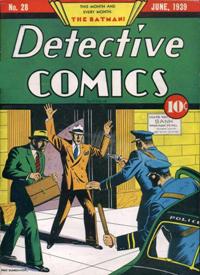 |
|
Main feature
- Batman, Untitled
(later entitled "Frenchy
Blake's Jewel Gang") (6
pages) Part 1 of 1
REPRINT - The Batman
feature is reprinted in Batman
Archives Volume 1 and Batman
Chronicles Volume 1.
LOCATION - unnamed
VILLAIN - Frenchy
Blake and his Gang (Gloves, Ricky
and Slick)
NOTES - 1st
appearance of the Batrope
|
|
|
|
| |
SYNOPSIS
"THE
BAT-MAN,
A MYSTERIOUS AND AVENTUROUS FIGURE,
FIGHTING FOR RIGHTEOUSNESS AND APPREHENDING THE
MENACES OF SOCIETY IN HIS LONE BATTLE AGAINST THE
EVIL.
HIS IDENTITY REMAINS UNKNOWN. (HE
IS ONE BRUCE WAYNE, BORED YOUNG SOCIALITE)"
|
| |
| By
impersonating Commissioner Gordon over the phone,
Bruce Wayne succeeds in extracting information
from a police informant regarding a recent series
of jewel robberies which are seemingly the work
of one Frenchy Blake. Donning his
crime fighting disguise, he then seeks out a pair
of Frenchy's handymen as the Bat-Man and
successfully stops them in their tracks following
yet another robbery.
|
| |
|
| The police arrive
just as the Bat-Man recovers the stolen
jewels and heads off with them - making
it seem as though the Bat-Man has
actually joined forces with Frenchy.
However, this is all just a plan Bat-Man
has devised in order to lull Frenchy into
a false sense of security as the police
are now concentrating on the Bat-Man and
thus affording Frenchy room to move and
carry on with his robberies. However,
the police force turns out to be Frenchy
Blake's least problem as the Bat-Man
finds him out and, after a brief physical
fight, forces the thief into signing a
confession.
Together with more
stolen jewels, Frenchy and the confession
make a nice parcel to be dropped off at
the police station.
|
|
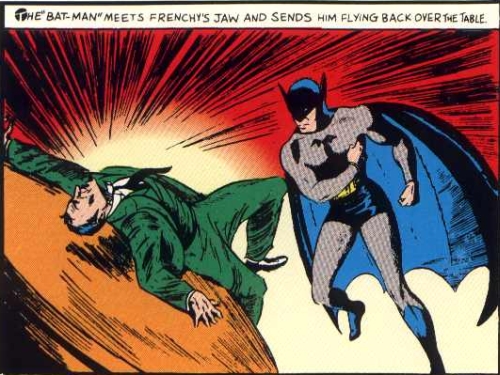
|
|
|
| |
REVIEW
The
second adventure of "The Bat-Man" in Detective
Comics features little more than a raw plot
framework and a highly unspectacular story, all
of which doesn't really make the artwork look
better either. However, from a retrospective
point of view there are several introductions
which develop the character further from where he
had left off in Detective Comics #27 and
take the Bat-Man one step closer towards what
would eventually become the Batman Mythos.
Most
importantly, this concerns the dual personality
dynamics of Bruce Wayne / Batman (where readers
are shown in this issue that both identities can
be used and combined to good effect for crime
fighting purposes).
|
| |
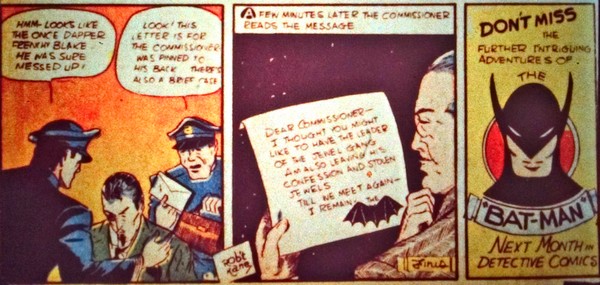 |
|
Readers are also
introduced to the Batman's leaning
towards an arsenal of gadgets (still very
low tech for the time being, but
nonetheless effective, such as the
Batrope introduced in this issue). Another
point which would turn into a recurring
motif is the dropping off of criminals
ready for the police to just pick up,
including an attached note to the
Commissioner, and thus like leaving a
calling card.
|
|
| |
FACTS
& FIGURES
Batman
does not appear on the cover of Detective
Comics #28, but an inset at the top reads THIS MONTH AND
EVERY MONTH: THE
BATMAN ! - also highlighting the still
unsettled question of a spelling convention and
therefore variants appearing in the same issue
(Bat-Man, Batman).
|
|
| |
|
| |
DETECTIVE
COMICS #29

July 1939
"The
Batman meets Doctor Death"
|
|
Story - Gardner F.
Fox
Art - Bob Kane,
Jerry Robinson
Inks - Bob Kane
Colours - NN
Lettering - Bob Kane
Editor - Vincent
Sullivan
Cover - Bob Kane
|
|
|
|
| |
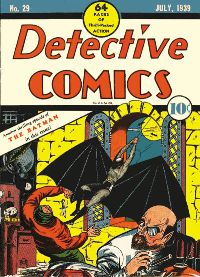 |
|
Main feature - Batman,
"The Batman meets Doctor Death"
(10 pages) Part 1 of 1
REPRINT -
The Batman feature has been reprinted in Batman
from the Thirties to the Seventies (1971),
Batman Archives Volume 1 (1990)
and Batman Chronicles Volume 1
(2005).
LOCATION -
unnamed
VILLAIN - Doctor
Death (Doctor Karl
Helfern)
NOTES - 1st
appearance of a true Batman villain
(Doctor Death), 1st
detailed description of the utility belt
|
|
|
| |
SYNOPSIS
"THE BAT
MAN, EERIE FIGURE OF THE NIGHT,
HAS BECOME A LEGENDARY FIGURE IN THE LIFE OF THE
TEEMING METROPOLIS,
RIGHTING WRONGS AND BRINGING JUSTICE WHERE IT HAS
NEVER BEEN BEFORE..."
|
| |
|
| At last, Doctor Karl
Helfern has completed his experiments on
producing a death bringing pollen extract
and is now ready to blackmail the wealthy
of the world by threatening to use his
invention on them. But before he can
proceed with his final plans, Helfern
knows he will need to do away with the
Batman to be certain of success... Not
knowing the Batman's true identity, he
places a contact notice for him in the
personal column of the daily newspapers,
which attracts the attention of Bruce
Wayne.
|
|
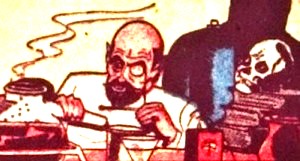
|
|
|
| |
| The young
socialite anonymously picks up a letter at the post
office which tells Batman that at a particular time and
place a murder will take place. Wayne loses no time,
rushes home and changes into the Batman, equipping
himself with a few items he thinks might come in handy,
such as choking gas pellets placed in his utility belt. The Batman reaches
the address indicated in the letter and, using his
suction pads, scales the outer walls until he reaches the
penthouse roof. Upon entering the Batman is held at
gunpoint by two henchmen of Helfern, but he manages to
take them both out thanks to his agility and speed. The
gangsters refuse to tell Batman who sent them for fear
that they will be killed, however, at that very moment
the Indian manservant of Helfern - a mountain of a man
called Jabba - enters the room and tells Batman that "Doctor
Death sends his greetings"... Jabba shoots and
wounds the Batman, who in turn uses his choking gas
pellets and is thus able to make his getaway.
In spite of
this failure, Helfern a.k.a. Doctor Death decides to proceed
with his plans and orders Jabba to kill one John P. Van
Smith, who refuses to pay, with the deadly pollen. By
chance, Bruce Wayne sees and recognises Jabba in the
street and is able to foil the murder attempt on Van
Smith. He then trails Jabba and thus learns of the
whereabouts of Doctor Death, enabling him to pay the
Doctor a visit by night - as the Batman.
Helfern
attempts to escape by using a hidden chute, but the
Batman is hot on his heels and follows him into his
laboratory. Here, the Batman hurls a fire extinguisher at
the Doctor who drops a test tube with a highly flammable
substance, and as the flames blaze around him he begins
to laugh madly. The Batman turns from the scene and
solemnly remarks -- "Death... to Doctor
Death."
|
| |
REVIEW
After
only two appearances in Detective Comics
the Batman has obviously built up a reputation
amongst those dealing in crime in this (still
unnamed) "teeming metropolis",
and Doctor Helfern alias Doctor Death thus knows
fully well that he will need to deal with the
Batman before any of his plans have a chance of
succeeding.
As
simple as this plot device may be, it is in fact
a fundamental cornerstone of the superhero comic
book genre which has driven countless storylines.
Its importance lies in the effect of creating a
relationship between the superhero and the
villain and taking the conflict to a meta level
where the villain is not just a common criminal,
but rather a super villain.
The
effect this has can be seen at once in Detective
Comics #29. Unlike the preceding two
adventures - where his opponents were simply
crooks and gangsters - the Batman now faces a
villain who actually has some personality and a
diabolical scheme. Accordingly, his name is not
Alfred Stryker or Frenchy Blake - he is a mad
scientist and has chosen to call himself Doctor
Death.
Detective
Comics #29 is significant for introducing
this supervillain element very early on in
Batman's career - an element which would become a
major factor in the Batman mythology as his major
villains would eventually become essential in
defining the vigilante and ultimately be as
iconic as the Darknight Detective himself. Doctor Death is thus the
first real "Batman villain" as he in
fact also sets out to do away with the Caped
Crusader - the first in what would become a long
line of characters.
This
change in who Batman is up against - a scheming
villain and not just a common criminal - was
introduced by Gardner F.
Fox, who was 28 at the time,
held a law degree and had started scripting for
DC with Detective Comics #4 (Marx,
1985). His influence on shaping aspects in the
very early Batman which, ultimately, would become
essentials for the character, was substantial and
make it fairly easy to overlook some rather less
convincing aspects of his storytelling details -
such as the rather obscure method of killing
people as devised by Doctor Death (i.e. by
blowing pollen at them).
The
story per se is thus not consistently credible
and presents no real surprises, but the details
which Fox worked into it make it fly all the
same. Fox enhances and underlines the importance
of Batman's special equipment, and readers learn
for the first time what the Batman actually puts
away in his utility belt (which was there
visually before but gets a real meaning for the
first time in this issue).
"Gardner Fox was
(...) not the greatest writer, but very
capable and reliable, a good plot man."
(long-time DC editor
Julius Schwartz, in Schwartz & Thomsen,
2000)
However, once again,
it seems that the idea of giving Batman a utlity
belt came straight from the Shadow pulps too (Tollin, 2007
and Murray, 2007).
|
|
| |
FACTS
& FIGURES
Batman
graces the cover of Detective Comics for
the second time, and already the page count for
his third feature has increased from six to ten.
The still unsettled question of a spelling
convention is highlighted by the title panel
which labels the feature as "THE BAT-MAN" and
the story as "BATMAN MEETS DOCTOR DEATH".
|
| |
|
|
| |
DETECTIVE
COMICS #30

August 1939
[originally
untitled]
|
|
Story - Gardner F.
Fox
Art - Bob Kane,
Sheldon Moldoff
Inks - Bob Kane
Colours - NN
Lettering - Sheldon
Moldoff
Editor - Vincent
Sullivan
Cover - Fred
Guardineer
|
|
|
|
| |
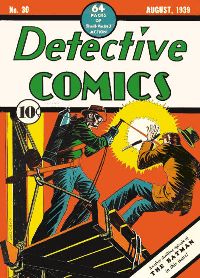 |
|
Main feature - Batman
Untitled (later entitled "The Return
of Doctor Death") (10 pages) Part
1 of 1
REPRINT -
The Batman feature has been reprinted in Batman
Archives Volume 1 (1990) and Batman
Chronicles Volume 1 (2005)
LOCATION -
unnamed
VILLAIN - Doctor
Death (Doctor Karl
Helfern)
NOTES - 1st
second appearance of a villain
|
|
|
| |
SYNOPSIS
"...IN
THE STRANGE LIVES OF THOSE DENIZENS OF THE HIDDEN
WORLD OF CRIME,
THE BATMAN,
WINGED FIGURE OF VENGEANCE HAS BECOME A MENACE..."
|
| |
| It
is less than a week since Doctor Death perished in
his flame engulfed laboratory (and a month in
real time, back in Detective Comics
#29), yet Bruce Wayne already has doubts about
what actually happened in Karl Helfern's lab as
he reads a newspaper story about a death which
sounds very much like the work of Doctor Death.
Posing as a reporter, Bruce Wayne visits the dead
man's home and finds his suspicions confirmed as
the victim's wife, Mrs Jones, tells him of a
blackmail note sent to her late husband by "a
Doctor Death". She also tells Wayne
that although they had lost most of their money
in the Great Depression, the blackmailers must be
after their diamonds. Filling up
his utility belt, Batman decides to pay the crime
scene another visit by night. Meanwhile, Doctor
Death is seen to now have a fully bandaged head
(looking strikingly similar to DC's 1970s
character Unknown Soldier) and still to be
reliant on the services of a huge man servant,
now answering to the name of Mikhail and sent to
steal the Jones diamonds.
At
the Jones home, Batman lets Doctor Death's
henchman steal the diamonds from the safe in
order to follow him to Doctor Death, but Mrs
Jones has trouble sleeping and virtually walks
into Mikhail. This turn of events forces Batman
out of his hiding as the henchman is about to
shoot Mrs Jones, an attempt foiled only by a
swift uppercut from the Batman. Having taken care
of Mrs Jones, Batman looks after Mikhail who is
about to regain consciousness. In order to be
able to track down Doctor Death, Batman leaves
the diamonds with Mikhail who, coming back to,
can hardly believe his luck and proceeds to a
pawnshop.
|
| |
|
| Then following the
henchman back to his private lodgings,
Batman knocks out Mikhail with a choking
gas pellet from his utility belt.
However, a search of the room reveals
absolutely nothing, and to make things
worse Mikhail is back in action and
musters a lot of resistance in the
ensuing fight before finally giving out. The
Batman returns to the Pawn Shop and
confronts its owner, Ivan Herd, who now
is in possession of the Jones diamonds.
Trying to escape, he his held back by
Batman's batrope. Finding that Herd is
wearing a wig, the Batman discovers that
he is also wearing a skin mask --
revealing the now hideously burnt face of
Doctor Death.
Batman ties up Doctor
Death and leaves the Jones diamonds with
him as the police are arriving.
|
|
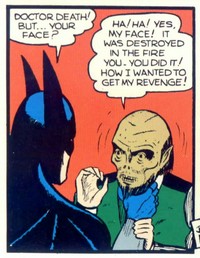
|
|
|
| |
REVIEW
The
merits of Detective Comics #30 are
quickly told - Gardner Fox presents the first
ever "comeback" of a Batman villain
with the second appearance of Doctor Death,
following his introduction in the previous issue.
Fox also casts the mould for the return of
countless villains from what seemed to be certain
death - in this case thanks to a hidden trap
door. And whilst Fox thus shows that the death of
villains in comic books should never be taken to
be a permanent departure, the "return from
the dead" more often than not comes at a
price - in this case in the form of a hideously
disfigured face.
An
important issue for the history of the Batman
mythology, Detective Comics #30 falls
short of any such rating on the story level. The
return of Doctor Death is presented in a rather
aneamic storyline which suffers further from a
whole string of inconsistencies and logical slips
- why Batman should know the combination to the
Jones safe, for instance, is rather inexplicable.
The loose ends of the contrived plot are not
helped by the artwork either, as Mikhail does not
notice Batman trailing him through empty streets
although he could almost be his shadow. Overall
the story feels muddled and ill timed, as the
plot is first drawn out only to see the ending
come about in a rush.
|
| |
FACTS
& FIGURES
Batman
does not appear on the cover of Detective
Comics #30, but a notice running across the
lower right hand corner reads Another
thrilling episode of THE BATMAN in this issue.
Backgrounds
of this story were pencilled by Sheldon Moldoff,
who would become one of the primary Batman ghost
artists for Bob Kane throughout the 1950s. In
terms of visuals, the Batman's ears seem to be
drawn longer and longer, reaching new heights in
this issue - showing how the apperance of this
still new superhero was an ongoing process of
back and forth.
|
|
| |
|
| |
DETECTIVE
COMICS #31

September
1939
[untitled]
|
|
Story - Gardner F.
Fox
Art - Bob Kane,
Sheldon Moldoff
Inks - Bob Kane
Colours - NN
Lettering - Sheldon
Moldoff
Editor - Vincent
Sullivan
Cover - Bob Kane
|
|
|
|
| |
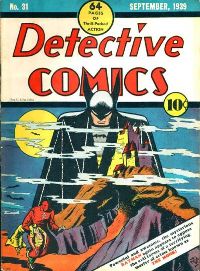 |
|
Main feature - Batman
Untitled (later entitled "Batman
versus the Vampire (I)") (10 pages) Part
1 of 2
REPRINT -
The Batman feature has been reprinted in 100-Page
Super Spectacular DC-14 (1973), Greatest
Batman Stories Ever Told (HC, 1988),
Greatest Batman Stories Ever Told
(TPB, 1989), Batman from the Thirties
to the Seventies (1971), Batman
Archives Volume 1 (1990) and Batman
Chronicles Volume 1 (2005)
LOCATION -
New York City, the Atlantic Ocean, Paris
VILLAIN -
The Monk
NOTES - 1st
appearance of the Batarang and the
Batgyro; first naming of the Batman's
city of operation (New York City); first
Batman adventure which carries over into
the next issue
|
|
|
| |
SYNOPSIS
"POWERFUL
AND AWESOME,
THE MYSTERIOUS BATMAN AGAIN
APPEARS TO OPPOSE
THE EVIL FORCES OF A TERRIFYING MASTER OF CRIME
KNOWN AS THE MONK
!"
"THE
BATMAN - WEIRD MENACE TO
ALL CRIME - AT LAST MEETS AN OPPONENT WORTH OF
HIS METTLE.
A STRANGE CREATURE, COWLED LIKE A MONK, BUT
POSSESSING THE POWERS OF SATAN !
A MAN WHOSE POWERS ARE UNCANNY, WHOSE BRAIN IS
THE PRODUCT OF YEARS OF INTENSE STUDY AND
SECLUSION !"
|
| |
| Batman
prevents a man being murdered by a woman who
obviously is under some sort of hypnotic spell.
The attacker turns out to be Bruce Wayne's
fiancée Julie Madison. After driving her home in
silence the Batman leaves her with the
instruction to inform Bruce Wayne of what
happened. The next day, upon hearing the story
from Julie, Bruce Wayne accompanies her to Dr
Trent who confirms that the symptoms indicate her
being the victim of an expert hypnotist. As
therapy, he recommends an ocean voyage. However,
as Dr Trent continues to advise a trip to Paris
and then later Hungary ("the land of
werewolves!" as he mysteriously adds),
Bruce Wayne notices the strangely staring eyes of
the therapist and begins to wonder. |
| |
| Determined to
keep an eye on her, Bruce follows
Julie in the guise of Batman
using his new Batgyro whilst also
taking with him his latest
weapon, a Batarang - fashioned on
the working principles of the
Australian boomerang. Out at sea,
the Batman sets his Batgyro to
automatic pilot and descends down
to the ship and finds Julie
falling under another hypnotic
trance. The man responsible for
Julie's state is a masked figure
clad in red and wearing a hood
with a crossbones symbol - "the
arch-villain known as the
Monk!"
Batman breaks
the Monk's spell on Julie and
then returns to his Batgyro,
following the ship and the monk
to Paris, where after a lengthy
search he finally finds Julie.
However, breaking into the Monk's
headquarters he also finds that
various traps have been set up
for him - a gigantic fighting
gorilla, a trap door, and a giant
net. Ultimately, Batman is the
Monk's prisoner but narrowly
escapes being dumped into a den
of snakes through the use of his
Batarang. Facing off the gorilla
once again, the Batman pursues a
car racing away and finds Julie
as lone passenger in that
vehicule - at least, she is in
safe hands now.
Knowing that
the Monk likely traveled to his
estate in Hungary, he sets the
automatic controls of the Batgyro
accordingly and flies off
together with Julie to the
vicious Monk's homeland.
"CONTINUE
THE
THRILLING ADVENTURE OF THE BATMAN
AND HIS COMBAT AGAINST THE
MYSTERIOUS MONK !
WHAT PLANS HAS THE MONK IN MIND ?
WHY DOES HE WANT JULIE ?
SEE THE NEXT
EPISODE OF THE BATMAN."
|
|
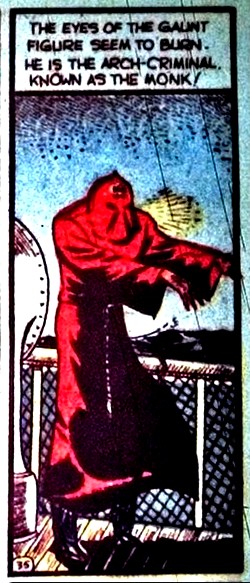
|
|
|
| |
REVIEW
The
schematic of Gardner Fox's take on the Batman
which could be seen over the course of the
previous two issues of Detective Comics
becomes even more pronounced - very strong on
fundamentals but increasingly weak on specific
storyline aspects.
In
the case of the first part of Batman's encounter
with the Monk, Fox suits up the Batman with an
ever growing arsenal of purpose-developed weapons
(Batarang) and beyond state of the art transport
technology (Batgyro), an important cornerstone of
the Batman mythology as we know it today. Fox
also realized how important it is to have Batman
face off with villains who are on a par with him
also in turns of appearance. Naturally, like
Doctor Death who preceded him, the Monk can
hardly be labelled a major villain, but the
formula in the making is there and clearly
visible.
|
| |
| On
the story level, however,
almost nothing of what
Gardner Fox put together
for this first encounter
with the Monk makes any
sense at all. What
precisely is this
villain's masterplan? Why
would he want to
hypnotize Julie to get
her to kill someone in
New York City ("I
have been sent to you by
the Master Monk!")
- why her, why him? And
what is the actual goal
of all of this
hypnotizing (Julie, the
Doctor, in NYC, on the
steamer to Europe, in
Paris ...) because after
going to all of this
trouble he seems to
simply want to feed Julie
to the werewolves in his
homeland? The
behaviour of Bruce Wayne
and Batman in this
contrived concoction of
happenstance, however, is
even less understandable.
Why subject Julie to all
of these dangers rather
than simply pull the plug
on all of this travelling
to werewolf country ?
Both Bruce Wayne and
Batman seem completely
unable to ascertain the
relevant and important
from the silly and dumb.
|
|
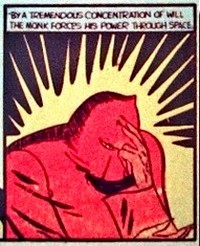
|
|
|
|
|
| |
| Overall,
the story - even granted it's only the first of
two parts - is little more than a raw mix of
vignettes (hypnotism, the Monk, Paris, traps,
giant Gorilla, werewolves, Hungary...) linked
with next to no coherent plot logic at all. The
last panel promises that the monk's plans for
Julie will be revealed, but today's readers will
find it rather hard to have any faith in this
announcement at all. Surprisingly
- or maybe shockingly - this two-part story has
been reprinted by DC on several occasions and
even included in the 1980s anthology The
Greates Batman Stories Ever Told. One can
only assume that Gardner Fox's masterplan aspects
for the Batman mythology - including the first
visuals of a giant bat silhouette in the night
sky as Batman glides along in his Batgyro - seem
to outweigh the appalling qualities of the plot
proper. One might even assume that if this were
not a Batman story it would have long been
covered by thick layers of dust and erased from
the collective memory of comic book history.
Alas, that is not the case.
|
| |
FACTS
& FIGURES
The
cover of Detective Comics #31 is one of
the most iconic of all and was paid hommage to by
Neal Adams with his cover to Batman #227.
The
events and characters depicted in Detective
Comics #31-32 were retold in 1982 by Gerry
Conway who revisited Batman's firts ever
villains, Doctor Death and The Monk, in a
multi-issue crossover between Batman and
Detective Comics (cf. THOUGHT
BALLOON #36) as well as
by Matt Wagner in his 2006 mini-sereies Batman
and the Mad Monk.
The
bat-silhouette in the sky takes shape for the
first time as Batman glides through in his
Batgyro, causing quite some concern amongst those
witnessing the event.
Detective
Comics #31 features the first instance of
what will become a hallmark of the early years of
Batman's adventures: the Darknight Detective
finds himself tied up and must find a clever way
to cut his way out of this predicament.
|
|
| |
|
| |
DETECTIVE
COMICS #32

October 1939
[untitled]
|
|
Story - Gardner F.
Fox
Art - Bob Kane,
Sheldon Moldoff
Inks - Bob Kane
Colours - NN
Lettering - Sheldon
Moldoff
Editor - Vincent
Sullivan
Cover - Fred
Guardineer
|
|
|
|
| |
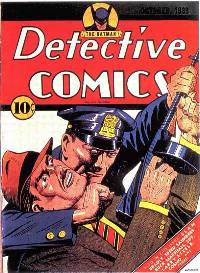 |
|
Main feature - Batman
Untitled (later entitled "Batman
versus the Vampire (II)") (10 pages) Part
2 of 2
REPRINT -
The Batman feature has been reprinted in 100-Page
Super Spectacular DC-14 (1973), Greatest
Batman Stories Ever Told (HC, 1988),
Greatest Batman Stories Ever Told
(TPB, 1989), Batman from the Thirties
to the Seventies (1971), Batman
Archives Volume 1 (1990) and Batman
Chronicles Volume 1 (2005)
LOCATION -
Hungary
VILLAIN -
The Monk, Dala
NOTES -
1st appearance of Dala, the Monk's
vampire servant
|
|
|
| |
SYNOPSIS
"FOLLOWING HIS
FIANCEE, THE BATMAN,
IN REALITY BRUCE WAYNE,
HAS TRAILED A SINISTER FIGURE COWLED LIKE A MONK,
TO HUNGARY..."
|
| |
| In
pursuit of the Monk (Detective Comics
#31) the Batman flies the Batgyro to Hungary and
there attacks a stagecoach which he believes to
be the property of the Monk. However, its only
occupant is a dazed young woman named Dala.
Batman takes her back to his hotel where his
fiancee Julie Madison is staying. However, Dala
reveals herself to be a vampire servant of the
Monk and attempts to attack Julie. Batman is
knocked out by Dala and finds that Julie displays
the mark of the vampire on her neck when he
regains consciousness. Seeing Dala leave the
hotel grounds, he stops her in her tracks. She
begs Batman to kill her master in return for her
information as to where Bataman can find him. |
| |
| Batman
takes Dala into the
Batgyro and they fly
towards the Monk's
castle. Their flight,
however, is grounded as
the Batgyro becomes
trapped in a giant net.
The Monk uses his
hypnotic powers to
capture Batman and
reveals to him that he is
a master vampire with the
powers of a werewolf. He
then casts Batman into a
pit with snarling, savage
wolves, but using gas
pellets from his utility
belt and his silken
Batrope the Darknight
Detective manages to
escape from the pit. As
dawn rises over the
country, the Batman
searches the castle until
he finds the coffins
housing both the Monk and
Dala. Melting down a pair
of silver candlesticks he
produces two silver
bullets which he fires at
the two vampires, thus
destroying their reign of
terror. FINIS.
REVIEW
The
second part of this story
fits in with the first,
and there seems to be an
established common view
today that this is the
most poorly written
Batman adventure of the
early years with nothing
but a mess of a story.
|
|
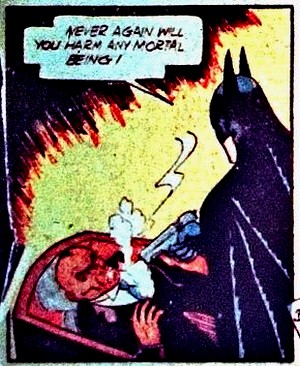
|
|
|
|
| |
| The
constant lapses in logic and common sense
continue and are certainly not helped by slip-ups
such as Batman's hotel supposedly being set in
the "Carlathan Mountains", which no
doubt should have been the Carpathian Mountains.
It's a small glitch, but it's telling for this
story: very little seems right, and even less
seems to fit as all the questions raised in the
first part are left completely open and
unanswered. Overall, this Batman two-part
story shows to good effect that most comic book
writers in the late '30s were simply writing
"kiddie stuff" and as such seemed to
care little to nothing about consistency - and
got away with almost anything. Possibly, Gardner
Fox and some of his contemporary colleagues would
have invested slightly more thinking and plotting
if they had known that their work would be
scrutinized decades later by a readership far
removed from the perspective of an eight year
old...
|
| |
FACTS
& FIGURES
Batman
does not appear on the cover of Detective
Comics #32, but he has taken his place in
the masthead logo.
Dala
and the Monk would return in Batman #350
in 1982, crossing over into Detective Comics,
although by that time it was established that the
events in Detective Comics #31-32 had
taken place on Earth-Two of DC's Multiverse and
those kicking off in Batman #350 were events on
Earth-One.
|
|
| |
|
| |
DETECTIVE
COMICS #33

November 1939
"The
Batman wars against the Dirigible
of Doom"
|
|
Story - Bill Finger
(Origin), Gardner F. Fox (Main
Story)
Art - Bob Kane,
Sheldon Moldoff
Inks - Bob Kane
Colours - NN
Lettering - Sheldon
Moldoff, Fred Guardineer
Editor - Vincent
Sullivan
Cover - Bob Kane
|
|
|
|
| |
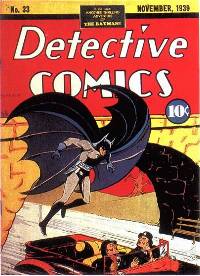 |
|
Main feature
- Batman "The
Batman wars against the Dirigible
of Doom" (12 pages) Part 1 of 1
REPRINT - The Batman
feature has been reprinted in Batman
Archives Volume 1 (1990) and Batman
Chronicles Volume 1 (2005);
the two page origin has
additionally been reprinted in Batman
(Signet Books, 1966), Batman
from the 30s to the 70s
(1971), Secret Origins
#1 (1973) and Batman in the
Forties (2004)
LOCATION - Manhattan
(NYC)
VILLAIN - Professor
Carl Kruger and the Scarlet Horde
NOTES - First
appearance of the Origin of
Batman (2 pages), written by Bill
Finger; first use of bulletproof
vest by Batman
|
|
|
|
| |
SYNOPSIS
"BATMAN
... EERIE FIGURE OF THE NIGHT - NEMESIS OF CRIME
- THIS IS THE
BATMAN !"
"LEGEND: THE
BATMAN AND HOW HE CAME TO BE !!"
|
|
| |
*
* *
Some fifteen years
ago Bruce Wayne's parents are ruthlessly
gunned down by a stick-up man. Vowing to
avenge their death, Bruce dedicates
himself to the achievement of physical
and mental perfection.
Using his thus
acquired unsurpassed skills, Bruce
decides to begin his war on crime when he
reaches adulthood. Pondering on what
disguise he should wear , Bruce's
conviction that "criminals are a
superstitious and cowardly lot"
makes it all become clear in a flash when
a bat flies through an open window,
inspiring Bruce Wayne to become a
creature of the night -- the Batman.
* * *
Above the crowded
streets of Manhattan, a red dirigible
uses a terrible death-ray, killing
thousands. Batman investigates the events
and reaches the conclusion that Prof Carl
Kruger, suffering from "Napolean
Syndrome" and only recently released
from a mental institution, is the one
responsible. Batman breaks up a meeting
between Kruger and his lieutenants (three
other scientists who form The Scarlet
Horde) but is nearly killed when the
building is set afire.
Not to be put off,
Batman visits one of Kruger's men the
following night and is led to the
professors hideout where Batman tries to
sabotage the dirigible but is shot as he
is discovered - saved only by his
bullet-proof vest (the first time he uses
such a device, having learned his lesson
from previous incidents).
|
|
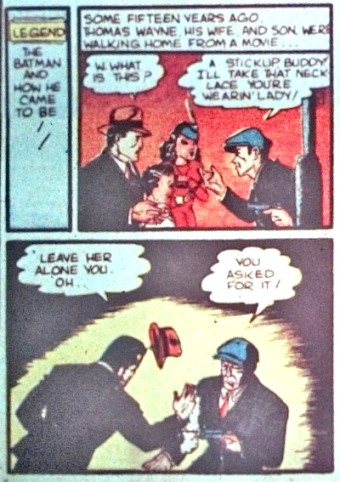
Essential Batman
mythology I: Thomas Wayne (and
immediately after that his wife) is
gunned down by a (still unnamed) gunman
in front of a terrified Bruce Wayne.
|
|
|
| |
| When
Kruger once again attacks the city in his
dirigible, Batman crashes the Batplane into it
and thus causes Kruger and his dirigible to
plunge from the sky. Whilst the Batman escapes
death, Kruger dies as his dirigible crashes into
a river. |
| |
REVIEW
The
main story by Gardner Fox works better than his
previous accounts of a Batman adventure -
possibly because there are no new elements
introduced to the persona and arsenal of Batman,
giving Fox more time to actually focus on the
overall plot logic. There are still some glaring
lapses of common sense (such as why the officials
would even consider releasing Professor Kruger
from a mental institution at a time when he was
telling the newspapers that he was planning to
start work on a new death-ray...) but at least
the inner structural coherence of the story
itself holds up. The tale of Kruger and his
Scarlet Horde and, above all, his dirigible (a
flying object possibly better known as a
"zeppelin") does have its moments of
interest and action, and certainly compares
favorably to the previous issues featuring Fox's
Monk.
From
today's perspective, however, the actual story is
completely irrelevant as it is overtowered by the
first account of Batman's origin, set out over
two pages by Bill Finger. A true cornerstone of
the Batman Mythos, the wherefore, why and how
"the Batman came to be" is all in place
and will remain virtually unchanged for
generations of readers yet to come: Bruce Wayne
witnessing the gunshot murder of his parents on
their way home at night from a movie, his
determined vow to fight crime as a consequence,
his extended physical and mental training, and
the events leading up to the choice of name and
character for his vigilante activities.
|
|
| |
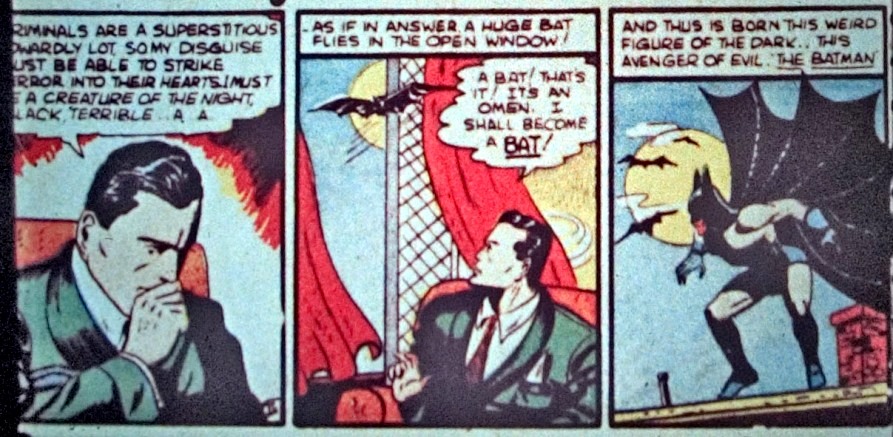
Essential Batman mythology
II: Searching for a suitable disguise to strike
fear (or even "terror", as Bill Finger
puts it) into the heart of the superstitious and
cowardly criminals, the answer comes to Bruce
Wayne in the form of a bat.
|
|
| |
| The
only things missing at this point are most of the
names associated with the Batman's origin - apart
from Thomas Wayne, the other personae involved
(Martha Wayne, Joe Chill) as well as the locale
(Crime Alley, Gotham City) are not specified at
this point in time. Just as the
visuals of the Batman were cast very early on in
his publication history, so was the story behind
this dark avenger of crime - after a mere six
months and the corresponding number of issues,
the mould for Batman was essentially complete.
|
|
| |
|
|
| |
DETECTIVE
COMICS #34

December 1939
[originally
untitled]
|
|
Story - Gardner F.
Fox
Art - Bob Kane,
Sheldon Moldoff
Inks - Bob Kane,
Sheldon Moldoff
Colours - NN
Lettering - Sheldon
Moldoff, Fred Guardineer
Editor - Vincent
Sullivan
Cover - Craig Flessel
|
|
|
|
| |
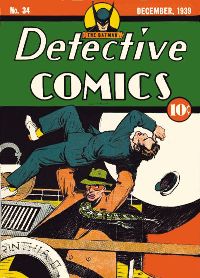 |
|
Main feature - Batman
Untitled (later entitled "Peril in Paris"),
10 pages Part 1 of 1
REPRINT -
The Batman feature is reprinted in Batman
Archives Volume 1 and Batman
Chronicles Volume 1
LOCATION -
Paris, France
VILLAIN -
Duc D'Orterre
NOTES -
|
|
|
| |
SYNOPSIS
"THE
BAT-MAN,
HAVING RESCUED HIS FIANCEE JULIE FROM A SINISTER
FIGURE NAMED THE MONK,
SEES HER SAFELY ON BOARD A BOAT FOR AMERICA.
HE IS TO FOLLOW HER LATER, WHEN HE BECOMES
INVOLVED IN A MYSTERY ...!"
|
| |
| Bruce
Wayne is just about to leave his hotel in Paris
when he walks into - a man without a face. This
person soon turns out to be Charles Maire, and by
coincidence Bruce also accidentally meets Karel,
Charles' sister. From her Bruce Wayne learns the
tragic story - how Karel and Charles once
attended a Bal Masque hosted by the Duc
D'Orterre, how the duke desired Charles' sister,
and how he used his mad technology to remove
Charles' face for interfering and shielding
Karel. Bruce Wayne decides that this
calls for Batman, and as such first searches the
sewers of Paris where he learns the location of
the duke's mansion. Upong going there, D'Orterre
captures him and straps Batman to a torture wheel
in the basement of his house, but then turns his
attention back to getting a grip on Karel Maire.
Batman escapes and uses his new Batplane to find
D'Orterre's car. Leaping down from the plane onto
the car, the two begin to struggle. Karel makes
good use of the situation and frees herself,
whilst Batman leaps from the vehicle before it
runs over the edge of a cliff and falls into the
void.
|
|
| |
REVIEW
The
final Batman story by Gardner Fox until 1947 (and
then 1964) features virtually all the downfalls
which make Fox's 1939 Batman stories so tough to
read today: anything happening is completely
contrived, triggered by the most unlikely
coincidences, and fantastic and/or odd villains
appear as dei ex machina, displaying a
complete lack of coherent actions and no plan at
all. Most elements remain unexplained without the
slightest blush - most notoriously in this issue
the Duc's "talking flowers with human
faces": here for one panel, gone for ever
thereafter.
Gardner
Fox's assignment to Detective Comics in
its 1939 run was an important element in the
building of the Batman mythos, as Fox together
with Kane and Finger developed the character.
Fox's most important contribution was the
build-up of Batman's arsenal of gimmicked
weapons, but his stories fell almost completely
flat. It would seem that readers in 1939 were
willing to accept almost anything.
|
|
| |
FACTS
& FIGURES
Chronologically,
"Peril in Paris" takes place
immediately after the events in Detective
Comics #32, indicating an editorial slip as
the cover of Detective Comics #33 belongs
to this story as well.
This
is the last cover of Detective Comics
not to feature Batman until issue #521 (December
1982) when Green Arrow was given a cover
appearance as the new backup feature.
A
detailed and fun analysis of the shortcomings of
this issue of Detective Comics is
available from the Legends of
the Batman podcast.
|
|
| |
|
| |
1939 IN SUMMARY
|
| |
| Batman's
first year in publication saw eight appearances
in the pages of Detective Comics and a
fairly stable creative team on the job, with Bob
Finger writing the first two scripts (issues #27
and #28) plus the two-page Batman origin story in
Detective Comics #33, and Gardner Fox
penning issues #29 through #34. |
| |
| The artwork for all
eight issues is credited to Bob Kane,
although it is now established that
Sheldon Moldoff (who would become one of
the primary Batman ghost artists for Bob
Kane throughout the 1950s) and Jerry
Robinson had a hand in Detective
Comics #30-#34. The
villains featured in 1939 were (in order
of appearance) Alfred Striker &
Jennings, Frenchy Blake and his gang, Doctor
Death, the Monk, Professor
Krueger and the Scarlet Horde, and Duc
D'Orterre. Whilst most of these were
simply thugs and criminals, Doctor Death
and the Monk stand out as being the first
true super villains Batman encounters.
Doctor Death is
Batman's very first antagonist with a
masterplan (although he does not possess
any superhuman powers or capacities), and
the Doctor's encounter with the Batman is
the very first multi-part two-issue
Batman adventure. Oddly enough, Batman's
first real bad guy was quickly put on a
shelf and only brought back 43 years
later when Dr Karl Hellfern a.k.a. Doctor
Death returned to haunt what by then had
become Gotham and the Darknight Detective
in early 1982, making his brief return to
Detective Comics in issue #512.
He endured the collapse of the so-called
DC Multiverse (a system of multiple
parallel worlds) in Crisis on Infinite
Earths (1985-86) and has reappeared
in Batman #692 (December 2009).
The Monk (who is a
vampire and wears a red monk-like outfit
and a hood that bears a yellow skull and
crossbones on it) is Batman's second
significant villain in chronological
order, and he is the first to feature
out-of-the-ordinary powers and capacities
- in his case by being a vampire. In his
first foray into the world of the
supernaturally fantastic, Batman kills
the Monk and his female assistant Dala by
shooting them with silver bullets
(unthinkable only a few months later, as
DC toned down the violence displayed by
Batman and banning guns alltogether), but
the Monk would return several decades
later in Detective Comics #515,
preceded by the return of Dala in Detective
Comics #511. His story was also
retold in Matt Wagner's six issue
miniseries Batman and the Mad Monk
(2006/2007).
The year also saw the
first appearances of a number of props
which would instantly become a vital part
of the Batman mythos, such as the Utility
Belt and the Batrope (Detective
Comics #29), the Batarang and the
Batgyro (Detective Comics #31)
as well as the Batplane (Detective
Comics #33) - whilst all throughout
the year Batman's roadster remained just
that: Batman's roadster.
|
|
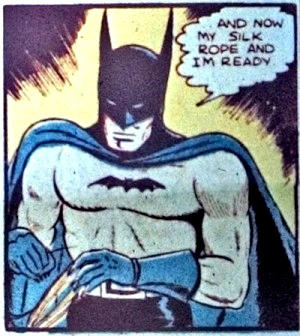
The characteristic
features of the Batman's visuals are
established early on in his publication
history (Detective Comics
#33, November 1939)
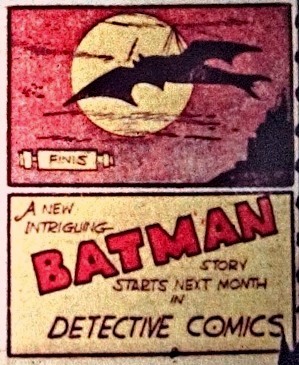
Final panel from
Batman feature in Detective Comics #32
(October 1939)
|
|
|
| |
| Equally
important to the Batman Universe is the founding
myth - the origin of Batman - which was featured
for the first time and in the form of a two page
flashback in Detective Comics #33. The locale,
however, is as yet not designated to be Gotham
City (which would first be mentioned in Batman
#4) but rather New York City (after a brief
initial period of not naming the locale at all).
On
the other hand, Batman travels widely during his
first few adventures, and solves mysteries in
Hungary and Paris, France.
|
|
| |
| According
to estimates of the Comics Chronology
(www.comichron.com) Detective Comics
sold around 200,000 copies per issue throughout
1939. |
| |
|
|
Bibliography
BRADLEY
Michael & Michael Kaiser (2011) "Episode 1 -
April 1939", Legends of the Batman Podcast,
accessible online
BROWNSTEIN Charles
& Diana Schutz (eds.) (2005) Eisner / Miller,
Dark Horse Books
JONES
Gerard (2004) Men of Tomorrow, Basic Books /
Perseus
MARX
Barry (ed.) (1985) Fifty who made DC great, DC
Comics
PORTER Alan
J. (2008) "The Dubious Origins of the Batman",
in Batman Unauthorized, Dennis O'Neil (ed.),
BenBella Books
SCHWARTZ
Julius & Brian M. Thomsen (2000) Man of Two
Worlds, Harper
|
| |
|
| |
BATMAN and all
related elements are the property of DC
Comics, Inc. TM and © DC Comics, Inc.,
a subsidiary of Time Warner Inc.
|
| |
First posted 13 August 2014
All characters, logos, and images are the
property of their current copyright holders.
They are used here for non-commercial review
purposes and considered fair use according to US
Code Title 17, Sec. 107.

(c) MMXIV
|
|

